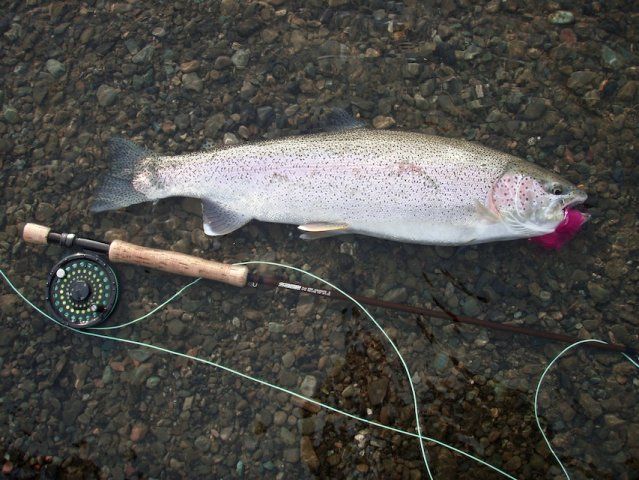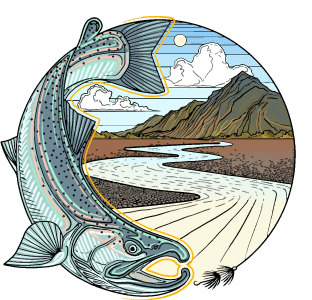Meet the Fish: Rainbow Trout
The resident relative of the steelhead, the rainbow trout is native to the Kenai, Southern Interior, Bristol Bay and limited parts of Southeast Alaska. Available from April to November in both lakes and rivers, the prime fishing time for rainbows occurs in August and September. The rainbow will respond to a large range of patterns, and "Matching the Hatch" in Alaska takes on a whole new meaning, as Alaskan rainbows are voracious feeders. From alevin and fry patterns in the spring to dry flies, nymphs, and mice in the summer and flesh flies in the fall, these hungry trout like meat. Throughout most of its range, the rainbow averages 2-6 lbs, but some rivers host trout that can reach 20+ lbs. Known for its fierce fighting ability and amazing jumping prowess, the rainbow is one of Alaska's premier sport fishing attractions.
Gear and Flies
Rainbow trout are found in a wide range of water types, and these types will have a bearing upon the choice of rod weights for the angler. A five-pound rainbow in still water can be subdued with a 4wt, but the same fish in the heavy flows of the Kenai would be unmanageable. For still waters, 3, 4, and 5 weight rods are good choices, and for river and stream fishing, 5, 6, and 7 weight are the tool of choice. Reels should also be chosen with water types in mind, as a large rainbow in a big river can peel line off in a hurry. For river applications, the large-arbor, high capacity reels are tough to beat. Depending upon the method of presentation, fly line choices include weight-forward floating lines, sinking tip lines, full-sink lines, and multi-tip systems to deliver your offering to the proper depth.
Rods
When choosing a rod for Alaskan rainbows, the size of the water and fish will dictate your choice. Some Alaska destinations will call for two or more rods. When fishing small streams where the trout average 12" -18", a good 9' 4-5 wt. will work nicely. If chasing the same fish on larger rivers or lakes, then a 9'6" or 10' 5 wt. is preferable When fishing big rivers like the Kenai, Kvichak or Naknek, a high-quality 9'-10' 6-8 wt. is a solid choice, with 10' 7 wts being the most popular for all around performance. If you could only pick one all around trout rod for Alaska, it is hard to beat the 9 foot 6 weight.
Chasing rainbows with a switch or Spey rod is a blast and is becoming hugely popular all over Alaska. A 3-4 wt switch rod is incredibly fun when chasing those 12-18" trout. If larger water and lakes are on the agenda, bump up to a 10'6-11'6" 5 wt. If you are going Kenai or Naknek big, shoot for nothing smaller than a 11' 6wt or 7wt. Finally, if big river Spey is your game, a 12'6-13'6 6-7 wt. rod will be the ticket.
Lines
Lines for rainbows can be all over the radar. When fishing dries, nymphs, eggs or beads, a really good weight forward line with a longer body is recommended. When stripping streamers, try a short fast sink tip to get that coneheaded leech or sculpin into the strike zone. When throwing mice out in Western Alaska, a shorter bulked up weight forward line is a must. When chucking huge articulated patterns on big water, the go to is going to be a fast 15'-24' sink tip that will dredge the bottom. The same rules apply to Switch and Spey. Matching the situation and technique used will greatly impove your catch rate.
Flies & Beads
Here a little research will go a long ways. Depending on location and the time of season, the rainbow trout's attention will be focused on salmon fry, sculpins, dries & nymphs, eggs, mice, and flesh. If there is a food source that is ample and abundant, rainbows will most likely key in on it and refuse other offerings. If food is scarce or in between seasons, there's a good chance that a trout will eat anything thrown its way. Contact us and we'll gladly help figure out the right flies or beads for your trip.






